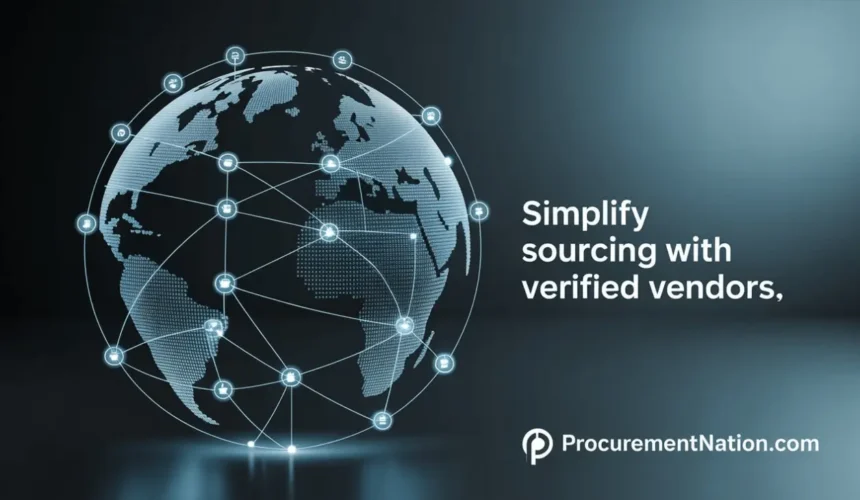ProcurementNation supply chain refers to the integrated approach and practices adopted by ProcurementNation.com in managing sourcing, procurement, logistics, and supplier relationships across the end-to-end supply chain. In today’s volatile market, having a robust supply chain is no longer optional — it is foundational to business resilience. With rising digitalization, sustainability demands, and geopolitical disruption, ProcurementNation supply chain strategies must evolve rapidly to stay competitive.
In this article, we will explore how ProcurementNation’s supply chain strategy addresses modern challenges, what tools and practices it uses, and what lessons organizations can draw to improve their own procurement and supply capabilities.
Key Components of ProcurementNation Supply Chain
A successful ProcurementNation supply chain is built on several interlocking components:
Strategic Sourcing & Supplier Management
ProcurementNation supply chain emphasizes strategic sourcing — selecting suppliers not just on price but on reliability, innovation capacity, and alignment with sustainability goals. Suppliers are managed through performance metrics, regular audits, and collaborative improvement programs.
Digital Procurement Tools & Platforms
To streamline operations, ProcurementNation deploys digital tools — e-procurement portals, spend analytics, supplier portals, contract management systems, and AI-driven demand forecasting. These systems increase visibility and reduce manual errors.
Demand Forecasting & Inventory Planning
Accurate forecasting is essential. ProcurementNation supply chain uses historical data, market trends, and predictive analytics to align procurement with actual demand, minimizing overstock and stockouts.
Logistics & Distribution Management
Once goods are acquired, the supply chain needs efficient transport, warehousing, and distribution. ProcurementNation coordinates with logistics partners, optimizes routes, and applies real-time tracking to ensure timely delivery.
Risk Management & Supply Continuity Planning
ProcurementNation supply chain incorporates scenario planning, supplier diversification, and buffer stock strategies to mitigate risks like supplier failure, natural disasters, political disruptions, or pandemics.
Sustainability & Ethical Sourcing
A modern supply chain must be responsible. ProcurementNation sets ethical standards, monitors supplier compliance with labor and environmental rules, and favors green sourcing initiatives.
Continuous Improvement & Metrics
Performance is measured via KPIs (cost savings, supplier lead times, defect rates, delivery reliability). ProcurementNation supply chain uses those metrics to drive improvement cycles, process optimization, and stakeholder feedback loops.
Why ProcurementNation Supply Chain Matters in 2025
Resilience in an Uncertain World
Supply chains face disruptions from pandemics, climate events, and geopolitical tensions. ProcurementNation supply chain strategies help organizations become more resilient by building redundancy, flexibility, and real-time response capabilities.
Cost Efficiency & Value Creation
ProcurementNation supply chain practices go beyond cost cutting: they focus on value creation — achieving innovation, service levels, and strategic partnerships while controlling total cost of ownership.
Digital Acceleration & Competitive Edge
Firms that embed digital technologies into procurement and supply gain faster cycles, better insights, and competitive differentiation. ProcurementNation supply chain is a showcase for integrating AI, automation, blockchain, and analytics.
Regulatory & ESG Pressures
Governments and investors increasingly demand environmental, social, and governance (ESG) transparency. ProcurementNation supply chain models incorporate supplier audits, carbon tracking, conflict minerals reporting, and ethics compliance.
Customer Expectations & Speed
Today’s customers expect fast, flawless delivery and supply transparency. A disciplined ProcurementNation supply chain ensures that products reach customers quickly and reliably, driving satisfaction and loyalty.
How ProcurementNation Implements Digital Transformation
E-Procurement & Supplier Portals
ProcurementNation supply chain uses e-procurement platforms to digitize RFQs, order processing, invoicing, and approvals. Suppliers interact via dedicated portals to submit quotes, track orders, and communicate.
Spend Analytics & AI Insights
By analyzing spend data across categories and business units, ProcurementNation identifies consolidation opportunities, maverick spend, and supplier consolidation. AI tools flag anomalies, predict demand shifts, and guide sourcing decisions.
Contract Lifecycle Management (CLM)
A central CLM system helps monitor obligations, renewal dates, compliance, and performance. It ensures that contracts are adhered to and that terms are optimized.
Supplier Performance Dashboards
Real-time dashboards aggregate metrics such as on-time delivery, quality rates, lead times, and corrective actions. ProcurementNation supply chain continuously monitors these dashboards to spot problems early.
Blockchain & Traceability (Where Applicable)
In industries demanding provenance (e.g., pharmaceuticals, food, luxury goods), ProcurementNation explores traceability via blockchain or immutable ledgers so every supplier transaction is logged and auditable.
Robotic Process Automation (RPA)
Routine tasks — data entry, invoice matching, order confirmations — are candidates for RPA. ProcurementNation integrates bots to reduce manual errors and free staff for strategic work.
Supply Chain Risk Management in ProcurementNation
Supply Diversification & Dual Sourcing
To reduce dependency on a single supplier or geography, ProcurementNation supply chain demands multiple qualified suppliers in different regions. This diversification mitigates regional disruptions.
Scenario & Stress Testing
ProcurementNation runs simulations for extreme events (port closures, raw material scarcity, supplier bankruptcy) and develops contingency plans and response playbooks.
Inventory Buffers & Safety Stock
Critical items maintain buffer stock, but levels are optimized using analytics to avoid excessive holding cost. The system triggers replenishment when thresholds near.
Supplier Audits & Financial Health Monitoring
ProcurementNation checks suppliers’ financial stability, capacity, risk exposure, and ESG compliance on an ongoing basis. Early warning signals help preempt disruptions.
Emergency Logistics & Alternate Routes
If primary shipping routes fail, ProcurementNation supply chain has backup carriers or alternative routes ready. It may use air freight, alternate ports, or cross-border routes as backups.
Strategies to Improve Your Supply Chain: Lessons from ProcurementNation
Integrate End to End Visibility
Track goods, orders, and spend continuously across procurement, production, logistics, and aftersales. Transparency enables faster decision making and anomaly detection.
Align Procurement with Business Strategy
ProcurementNation supply chain aligns sourcing choices with business goals — e.g., cost leadership, differentiation, sustainability — instead of treating procurement as a back-office function.
Harness Cross-Functional Collaboration
Procurement, operations, logistics, finance, and marketing should collaborate. Sharing forecasts, constraints, and customer insights leads to better decisions.
Invest in Skilled Talent & Change Management
Digital transformation fails without people. supply chain emphasizes training, change leadership, and upskilling procurement professionals in analytics and relationship management.
Adopt Agile Procurement Practices
Using sprints, cross-functional squads, and rapid prototyping helps procurement respond faster to changing conditions. supply chain may pilot small sourcing changes before scaling.
Use Data-Driven Decisions, Not Gut Instincts
Historical data, predictive algorithms, and real-time metrics should guide sourcing and inventory decisions more than intuition.
Continuously Evaluate & Improve
Make reviews, root-cause analyses, supplier feedback, and process audits part of the culture. supply chain maintains a Kaizen mindset.
Challenges & Pitfalls in ProcurementNation Supply Chain
Legacy Systems & Data Silos
Integrating older ERP or procurement modules with modern platforms is complex. Data silos hamper visibility. ProcurementNation must invest in integration and data governance.
Supplier Resistance to Digitization
Some suppliers—especially smaller ones—may lack digital maturity. Onboarding, training, and incentives are needed to bring them on board.
Cultural Resistance & Change Fatigue
Employees accustomed to manual processes may resist new tools. Strong change management and executive support are essential.
Overreliance on Complex Models
Sophisticated analytics models are powerful but can mislead with biased or low-quality data. supply chain must validate models and maintain human oversight.
Cost of Implementation & ROI Uncertainty
Implementing digital supply chain systems requires investment, and results may accrue slowly. ProcurementNation must define KPIs, track ROI, and phase rollouts.
Global Regulatory & Compliance Complexity
Operating across geographies means dealing with local laws, tariffs, trade restrictions, and customs regulations. Noncompliance can lead to delays or penalties.
Case Example: Applying ProcurementNation Supply Chain in a Manufacturing Firm
Imagine a mid-sized electronics manufacturer facing raw material supply volatility and rising logistics costs. By adopting the supply chain model, the firm does the following:
-
Deploys an e-procurement system to centralize sourcing across all plants.
-
Implements spend analytics to find redundant suppliers and renegotiate contracts.
-
Diversifies its supplier base across regions to reduce dependency.
-
Uses predictive demand modeling to align inventory with forecasted orders.
-
Establishes supplier performance dashboards with real-time alerts.
-
Sets up backup logistics routes and emergency contingency plans.
-
Launches supplier sustainability audits to ensure compliance.
Over time, the firm sees reduced stockouts, lower procurement costs, improved supplier performance, and greater resilience against disruptions.
Future Trends in ProcurementNation Supply Chain
Hyperconnected IoT & Real-Time Sensing
Sensors and IoT devices embedded in goods, shipments, or machinery feed real-time telemetry. supply chain systems will tap this data to optimize routing, inventory, and maintenance.
Predictive & Prescriptive AI
Beyond forecasting, AI will recommend optimal sourcing strategies, reorder timings, supplier choices, and even contract terms.
Supply Chain as a Service (SCaaS)
Firms may outsource segments of procurement or logistics as modular services. ProcurementNation’s model might evolve into provisioning supply chain modules to clients.
Circular Economy & Reverse Logistics
Sustainability demands reverse flows — returns, recycling, refurbishing. supply chain must integrate reverse logistics and circular design into standard workflows.
Digital Twins for Supply Networks
Virtual replicas of supply networks will allow simulation and “what-if” scenario testing. ProcurementNation would use twins to stress test and optimize before physical execution.
Blockchain for Transparency & Trust
Immutable blockchain records will verify provenance, compliance, and automating smart contracts when conditions are met. ProcurementNation may increasingly adopt such architectures
How to Begin Emulating ProcurementNation Supply Chain
-
Assess current gaps — map existing procurement and supply processes, identify pain points.
-
Define strategic goals — cost reduction, resilience, sustainability, speed.
-
Select digital enablers — choose tools that fit your scale and maturity.
-
Pilot small projects — start with one category or region before full rollout.
-
Onboard suppliers gradually — provide training and incentives for adoption.
-
Monitor KPIs closely — track spend, supplier performance, lead times.
-
Iterate & scale — refine based on feedback, then expand across categories and geographies.
FAQs
What exactly does supply chain stand for?
It means the set of practices and strategies developed by ProcurementNation.com to manage sourcing, logistics, supplier management, risk mitigation, and continuous improvement in a modern, digital-driven supply chain.
Is digital transformation essential for successful supply chain?
Yes. Without digital tools—analytics, e-procurement, dashboards—a supply chain lacks visibility and responsiveness necessary in today’s volatile markets.
How can small or mid-size firms adopt supply chain methods?
They should begin with pilot projects, pick a category or region, invest in scalable tools, bring in training, and evolve gradually. Full enterprise overhaul is rarely practical from day one.
How much investment is needed to revamp supply chain?
It depends on scale, legacy systems, and ambition. Some costs go into software, integration, training, change management, and supplier onboarding. Measuring ROI early helps justify further investment.
What are the biggest risks in supply chain modernization?
Resistance to change, weak data quality, supplier noncompliance, model overreliance, and unforeseen disruptions all pose risks that must be addressed proactively.
How do you measure success in supply chain efforts?
Key metrics include cost savings, supplier lead times, on-time delivery, defect rates, spend under management, stockouts, and responsiveness to changes.
Conclusion
ProcurementNation supply chain is more than a name — it encapsulates a forward-looking, digitally enabled, risk-aware, value-driven approach to procurement and supply management. By integrating strategic sourcing, smart tools, resilient practices, and continuous learning, organizations can build supply chains that thrive amid disruption.
If you aim to replicate that level of sophistication, start small, invest in talent, enforce metrics, and iterate. Over time, you’ll move from reactive procurement toward a proactive, strategic, and resilient supply chain — much like ProcurementNation does.







